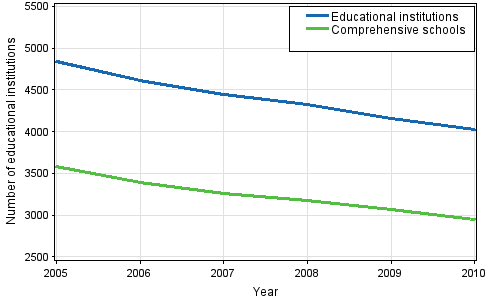Published: 17 February 2011
Number of educational institutions fell further
According to Statistics Finland's Register of Providers of Education and Register of Educational Institutions, there were 793 active providers of education and 4,023 educational institutions in which 1.96 million students pursued studies at the end of 2010. The number of all educational institutions has fallen by one sixth in five years. In 2005, the number of comprehensive schools was nearly 3,600, whereas at the end of 2010 their number was only just under 3,000.
Number of all educational institutions and comprehensive schools in 2005–2010

The number of providers of education was 11 lower than in 2009. Of the providers of education 48 per cent were municipalities or joint municipal boards, seven per cent were central government units and 43 per cent private. The remaining two per cent of the providers of education operated in the region of ┼land. In 2010, there were 13 new providers of education to be added to the Register of Providers of Education. The number of educational institutions was 138 lower than the year before.
Educational institutions of the school system and numbers of students by type of educational institution in 2010
| Type of educational institution | Number | Change from previous year 1) | Students 2) |
| 11 Comprehensive schools | 2 785 | -104 | 524 200 |
| 12 Comprehensive school level special education schools | 129 | -9 | 6 800 |
| 15 Upper secondary general schools | 395 | -3 | 120 100 |
| 19 Comprehensive and upper secondary general level schools | 38 | - | 25 000 |
| 21 Vocational institutes | 132 | -5 | 182 800 |
| 22 Special needs vocational institutes | 6 | - | 5 300 |
| 23 Specialised vocational institutes | 34 | -1 | 22 900 |
| 24 Vocational adult education centres | 25 | -2 | 43 100 |
| 28 Fire, police and security service institutes | 1 | - | 300 |
| 29 Military vocational institutes | 14 | - | .. |
| 41 Polytechnics | 27 | -1 | 148 000 |
| 42 Universities | 16 | -4 | 168 700 |
| 43 Military academies | 1 | - | 700 |
| 61 Music schools and colleges | 88 | -1 | 66 600 |
| 62 Sports institutes | 14 | - | 1 700 |
| 63 Folk high schools | 82 | -1 | 16 400 |
| 64 Adult education centres | 199 | -6 | 540 500 |
| 65 Study circle centres | 10 | -1 | 47 300 |
| 66 Summer universities | 20 | - | 36 700 |
| 99 Other educational institutions | 7 | - | 500 |
| Total | 4 023 | -138 | 1 957 600 |
2) The data on the number of students are mainly as on 20 September 2010 and include the number of all students in educational institutions belonging to the type of educational institution independent of the level of education.
There were 2,785 active comprehensive schools, which had 524,200 pupils. Special education schools at the comprehensive school level numbered 129 and they had 6,800 pupils. A total of 123 comprehensive schools or comprehensive school level special education schools were closed down or merged with another educational institution. Of these, 26 were educational institutions with under 20 pupils, 65 had between 20 and 49 pupils while 32 had at least 50 pupils. The number of closures was the highest in the regions of Varsinais-Suomi and North Ostrobothnia.
Of all comprehensive schools 75 per cent taught grades 1 to 6, 13 per cent taught grades 7 to 9 and 12 per cent of comprehensive schools taught all the grades from 1 through to 9. In all, 23 per cent of comprehensive schools had under 50 pupils and six per cent had over 500 pupils.
At the beginning of 2010, three new universities were established by merging universities. In this connection, the total number of universities fell by four to 16.
Source: Education Statistics 2010. Statistics Finland
Inquiries: Elina Huusko (09) 1734 3571, koulutustilastot@stat.fi
Director in charge: Jari Tarkoma
Publication in pdf-format (236.3 kB)
Updated 17.2.2011
Official Statistics of Finland (OSF):
Providers of education and educational institutions [e-publication].
ISSN=1799-5825. 2010. Helsinki: Statistics Finland [referred: 19.4.2025].
Access method: http://stat.fi/til/kjarj/2010/kjarj_2010_2011-02-17_tie_001_en.html

